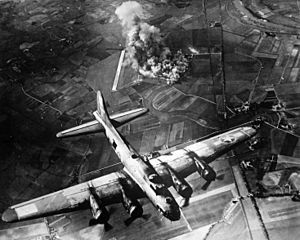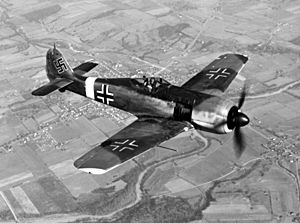Combined Bomber Offensive facts for kids
Quick facts for kids Combined Bomber Offensive (CBO)alias: Allied Bomber offensive |
|||||||
|---|---|---|---|---|---|---|---|
| Part of the Strategic bombing campaign in Europe | |||||||
 8th Air Force B-17 during raid of October 9, 1943 on the Focke-Wulf aircraft factory at Malbork, Poland (Marienburg in German). |
|||||||
|
|||||||
| Belligerents | |||||||
|
|||||||
| Commanders and leaders | |||||||
The Combined Bomber Offensive (CBO) was a huge air campaign during World War II in Europe. It involved Allied forces, mainly the United States and Great Britain. Their main goal was to bomb important targets in Germany.
From June 1943 to April 1944, the top priority was to attack the German air force, known as the Luftwaffe. Later, the focus shifted to bombing sites that produced V-weapons (special German rockets) and oil factories. They also attacked train stations and other transport links, especially before the invasion of Normandy. This bombing continued until the war ended in Europe.
The British Royal Air Force (RAF) usually bombed at night with many heavy bombers. The American forces, the United States Army Air Forces (USAAF), bombed during the day with large groups of bombers and their escort fighters. Together, they created a non-stop bombing effort, day and night, whenever the weather allowed.
Contents
Why Bomb Germany?
The Allies wanted to weaken Germany's ability to fight. They aimed to destroy German factories and military systems. They also hoped to lower the spirits of the German people.
The Casablanca Directive
In January 1943, Allied leaders met in Casablanca. They decided to start a "Bomber Offensive from the United Kingdom." The goal was to destroy German military, industrial, and economic systems. They also wanted to wear down the morale of the German people.
A special group of experts looked at German industries. They found key areas like oil, communications, and ball bearings that were vital for Germany's war effort. Attacking these "bottleneck" industries would hurt Germany the most.
The Pointblank Directive
On June 14, 1943, a new order called the Pointblank directive was given. It made attacking German fighter aircraft factories the highest priority. The Allies knew they needed to control the skies before they could invade France. This meant destroying German fighter planes and the factories that built them.
Some of the important factories targeted included those making Messerschmitt and Fw 190 fighters. These attacks were very dangerous for the Allied bombers, and they often suffered heavy losses.
Starting the Attacks
The Combined Bomber Offensive officially began on June 10, 1943. This was during the British bombing campaign against German industry in the Ruhr area, known as the "Battle of the Ruhr".
The Germans tried to trick the bombers. They built large fake targets, like the Krupp decoy site, which looked like the real Krupp steel works in Essen. These decoys were meant to draw Allied bombs away from the actual factories.
In July 1943, the USAAF and RAF worked together for the first time on a raid against Hamburg. However, smoke from the night bombing by the RAF made it hard for the USAAF to see their targets the next day.
Some British leaders, like Arthur Harris, believed the main goal was to destroy German cities and disrupt daily life. However, in February 1944, the official goal of the bombing campaign changed. It no longer mentioned breaking German morale. The new focus was purely on destroying Germany's military, industrial, and economic systems.
Key Operations
The Allies used new tactics and aircraft to improve their bombing efforts.
Long-Range Fighters
Early on, American bombers suffered heavy losses when flying deep into Germany. This was because their escort fighters couldn't fly far enough to protect them all the way. But in 1944, new fighters like the North American P-51 Mustang and Republic P-47 Thunderbolt arrived. These planes had the range to fly with the bombers deep into Germany and fight off German fighters.


General Jimmy Doolittle, who led the 8th Air Force, changed tactics. He allowed escort fighters to fly ahead of the bombers to "clear the skies" of German planes. This new freedom for the fighters greatly weakened the Luftwaffe. After bombing, the fighters could also attack German airfields and transport on their way back. This helped the Allies gain control of the skies over Europe.
Big Week
From February 20 to 25, 1944, the USAAF launched "Operation Argument," also known as "Big Week." This was a series of massive attacks on German aircraft factories. The goal was to force the Luftwaffe into a huge air battle. The Allies wanted to destroy the German air force once and for all.
Protected by their new long-range fighters, the American bombers attacked fiercely. The Luftwaffe had to defend its factories, leading to major air battles. The Allies won these battles, gaining air superiority. This victory was crucial because it meant the invasion of Western Europe (D-Day) could go ahead with less risk from German air attacks.
Battle of Berlin

While the Americans focused on specific targets by day, the British RAF continued its night-time "area bombing" campaign. This meant bombing large areas of German industrial cities, aiming to destroy factories and disrupt the lives of workers.
From November 1943 to March 1944, the RAF fought the Battle of Berlin. This involved 16 major raids on the German capital. The RAF hoped to turn much of the city into rubble and break German morale. However, the RAF suffered very heavy losses during this campaign. It did not achieve its main goal of winning the war by destroying Berlin. The high losses forced the RAF to pause its systematic destruction of Germany until later in 1944.
Outcome of the Offensive
The Pointblank operations helped to reduce the threat from the Luftwaffe. By the time of the Normandy Landings (D-Day), the German air force had very few planes left in northern France. This meant Allied planes could fly almost freely, greatly helping the invasion.
Even though German fighter production actually increased for a while, the constant fighting and the loss of experienced pilots weakened the Luftwaffe significantly. The long-range Allied fighters played a key role in winning control of the skies.
After the Normandy invasion, the top priorities for the Combined Bomber Offensive changed again. In June 1944, the focus shifted to attacking German rocket weapons (Operation Crossbow). In September, the main target became Germany's oil production. The strategic bombing campaign in Europe finally ended on April 12, 1945, just before the war in Europe concluded.
See also
- Operation Crossbow
- Oil Campaign of World War II
- Transportation Plan

